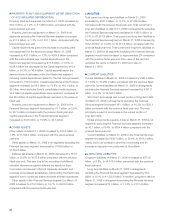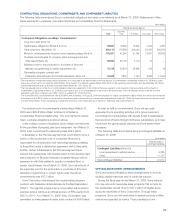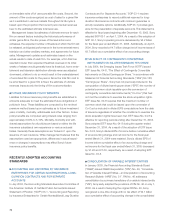Sony 2006 Annual Report Download - page 71
Download and view the complete annual report
Please find page 71 of the 2006 Sony annual report below. You can navigate through the pages in the report by either clicking on the pages listed below, or by using the keyword search tool below to find specific information within the annual report.
69
LIQUIDITY MANAGEMENT
Sony’s working capital needs grow significantly in the third
quarter (from October to December) as a result of the general
seasonality to Sony’s business. Sony’s basic liquidity manage-
ment policy is to secure sufficient liquidity throughout the
relevant fiscal year, covering such factors as short-term cash
flow volatility mentioned above, repayments for debts whose
due date fall within a year, and possible downward earnings risk
due to changes in the business environment.
Sony defines its liquidity sources as the amount of cash, cash
equivalents (“cash balance”), and committed lines of credit
contracted with financial institutions. Regarding its cash balance,
Sony’s policy is to maintain more than a certain level of cash
balance to absorb any working capital needs daily and monthly.
The balance of cash and marketable securities on March 31,
2006, was ¥589.5 billion. A short-term shortage in the cash
balance is financed by the issuance of CP. However, Sony
controls the outstanding CP amount through internal limits as
part of its short-term debt risk management strategy. In the
fiscal year ended March 31, 2006, there was no outstanding
CP amount.
As part of its additional liquidity sources, Sony has a total of
¥683.4 billion in committed lines of credit with various financial
institutions, of which the unused amount was ¥676.4 billion as
of March 31, 2006. Major committed lines of credit include a
total of ¥502.6 billion of Global Commitment Facilities contracted
with a syndicate of global banks, and a ¥150 billion of committed
line of credit contracted with Japanese financial institutions.
During the fiscal year ended March 31, 2006, Sony reorganized
the total amount and composition of terms to maturity of both
facilities. With regards to the Global Commitment Facilities, as
of March 31, 2005, Sony had two facilities consisting of a 5-year
contract (amount as of March 31, 2005 is ¥459.4 billion, maturity
March 2009) and a 364-day contract (amount as of March 31,
2005 is ¥114.9 billion) totaling ¥574.3 billion. During the fiscal
year ended March 31, 2006, the 364-day portion was terminated.
With regards to the committed line with Japanese financial
institutions, as of March 31, 2005, Sony had two facilities
consisting of a ¥100 billion 3-year contract and a ¥150 billion
364-day contract, totaling ¥250 billion. During the fiscal year
ended March 31, 2006, upon expiry of the 3-year contract,
Sony newly entered into a ¥150 billion 3-year contract (maturing
in July 2008) while the 364-day contract was terminated. As a
result, although the total amount of the facilities has been reduced
by ¥185.3 billion compared with the fiscal year ended March 31,
2005, Sony believes it maintains long-term secured and sufficient
liquidity. Sony uses these lines for general corporate purposes,
including the support of CP programs and for emergency
purposes. There are no financial covenants in any of Sony’s
material financial agreements that would cause an acceleration
of the obligation in the event of a downgrade in Sony’s credit
ratings. However, a downgrade in Sony’s credit ratings could
increase the cost of borrowings. There are no restrictions on
how Sony’s borrowings can be used except that some borrow-
ings may not be used to acquire securities listed on a U.S.
exchange or traded over-the-counter in U.S., and use of such
borrowings must comply with the rules and regulations issued
by authorities such as the Board of Governors of the Federal
Reserve Board.
RATINGS
Sony considers it to be one of management’s top priorities to
maintain a stable and appropriate credit rating in order to ensure
financial flexibility for liquidity and capital management, and to
continue to maintain adequate access to sufficient funding
resources in the financial and capital markets.
In order to facilitate access to global capital markets, Sony
obtains credit ratings from two rating agencies, Moody’s
Investors Service (“Moody’s”) and Standard and Poor’s Rating
Services (“S&P”). In addition, Sony maintains a rating from
Rating and Investment Information, Inc. (“R&I”), a rating agency
in Japan, for access to the Japanese capital market.
Sony’s current debt ratings from each agency are noted below:
Moody’s S&P R&I
Long-term debt A2 (Outlook: A- (Outlook: AA- (Outlook:
Stable) Stable) Stable)
Short-term debt P-1 A-2 a-1+
S&P downgraded Sony’s long-term debt rating from A to A-
and short-term debt rating from A-1 to A-2 in October 2005,
R&I downgraded Sony’s long-term debt rating from AA to AA-
in November 2005 and Moody’s downgraded Sony’s long-term
debt rating from A1 to A2 in December 2005, respectively.
Sony’s short-term debt rating from Moody’s and R&I have been
unaffected. These downgrades of debt ratings reflected rating
agencies’ concern mainly of low profitability in the Electronics
segment and the low level of Sony’s cash flows. The outlook
after the downgrades of long-term debt ratings from the three
agencies is stable. Despite these downgrades of debt ratings,
Sony believes its access to the global capital markets and
ability to issue CP for its working capital needs have not
been restricted.
CASH MANAGEMENT
Sony is centralizing and working to make more efficient its
global cash management activities through SGTS. The excess
or shortage of cash at most of Sony’s subsidiaries is invested or
funded by SGTS after having been netted out, although Sony
recognizes that fund transfers are limited in certain countries and
























